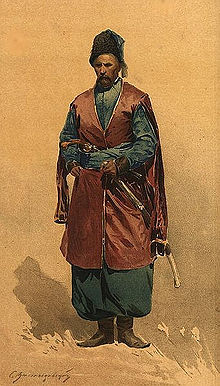- Polkovnik
-
Polkovnik (Russian: полковник, Polish: pułkownik, Ukrainian: полковник, Czech: plukovník; literally "regimentary") is often a military rank in Slavic countries which corresponds to a colonel in English-speaking states. However, in the Ukraine, polkovnyk was an administrative rank similar to a governor. Usually this word is translated as colonel, however the transliteration is also in common usage, for the sake of the historical and social context.
Contents
Name spelling
The exact name of this rank maintains a variety of spellings in different languages, but all descendant from the Old Slavonic word polk, and include the following:
- Czech Republic and Slovakia — plukovník
- Poland — pułkownik
- Slovenia — polkovnik
- Russia — полковник (Russian pronunciation: [pɐlˈkovnʲɪk])
- Ukraine, Bulgaria and Macedonia — полковник (Ukrainian pronunciation: [polˈkɔwnɪ̞k])
- Bosnia and Herzegovina, Croatia and Serbia — pukovnik
- Georgia — პოლკოვნიკი (Georgian: [pʼɔlkʼɔvnikʼi])
Etymology
Polkovnik began as a commander of a distinct group of troops, Old Slavonic polk (полк), arranged for a particular battle.
Russia
In late 17th century, polkovnik became the position of a regimental commander of the streltsy; this position also made it into New Regiments of the streltsy and later into the new army of Peter the Great. The rank was legalized by Table of Ranks that placed it in the 6th grade as the second-top field officer, right under the brigadier. A promotion to the rank of polkovnik gave a privilege of hereditary nobility.
The Red Army reintroduced the polkovnik rank in 1935, together with a number of other former Russian ranks, and it has been used in many ex-USSR countries, including Russia, to the present day.
The word polkovnik also means "stud" in Russian slang, strongly connotative of bravery or fearlessness.
Poland
The rank was first introduced in the Polish Army in 17th century to denote a captain (rotmistrz) of the core banner of a regiment. By the end of the century, the title of the assignment became a de facto rank as such and started to denote the commanding officer of the entire regiment. In mercenary troops fighting in the ranks of the Polish-Lithuanian Commonwealth's army, the direct equivalent of the rank of pułkownik was oberszter, but in 18th century the rank was abolished and renamed as pułkownik as well. During the rule of Sanacja in the period between World War I and World War II a large number of officers were promoted to the rank, often for political reasons (the rule of Sanacja was even dubbed the government of the colonels because of that). During the Invasion of Poland in 1939, the Polish divisions were commanded by officers of many grades, from colonels to three-star generals. In fact 22 divisions out of 42 were commanded by colonels in 1939. The pułkownicy (plural of pułkownik) did also command units of all sizes, from divisions down to mere battalions.
Ukraine
In the Zaporozhian Host, the political, social, and military organization of Ukrainian cossacks, polkovnyk was a high military rank among the Ukrainian cossack starshyna (officers), a commander of one or several military detachments during land and naval military actions in the sixteenth to eighteenth centuries. In the eighteenth century, a polkovnyk was a leader of a palanka, a territorial unit of the Zaporozhian Host. A palanka polkovnyk was elected by military council for one year. He represented the Kosh Otaman in the palanka and had significant powers, including the right to condemn cossacks to the death penalty. At the time of liquidation of the Zaporozhian Host by the Russian government in 1775 there were eight palanka polkovnyks. The polkovnyk's symbol of office was a pernach (a mace with a hexagonal head; see also bulawa), worn in the belt.
In the Registered Cossack Army of the Polish-Lithuanian Commonwealth polkovnyk was a commander of a regiment (полк), a cossack military unit. After the reform of the cossack army by hetman Mykhailo Doroshenko there were six cossack regiments, each comprising one thousand cossacks. Polkovnyks were elected by the Cossack Council (рада) and that had to be approved by the Polish government. A polkovnyk obtained salary for his service, and enjoyed considerable privileges. After adopting the "Ordination" by the Sejm of the Polish-Lithuanian Commonwealth in 1638, only noblemen (szlachta) were allowed to become polkovnyks.
During Khmelnytsky Uprising and in Hetmanate Ukraine polkovnyk was a head of a territorial administrative unit, the regiment (полк).
In modern Ukraine, polkovnyk is a military rank inferred from the similar rank of the Soviet Army.
Movie Trivia
In the film The Eagle Has Landed, Michael Caine wears the uniform and insignia of a pulkownik while in secret being an oberst in the German Luftwaffe.
See also
- Colonel
- Podpolkovnik
- Military ranks of the Soviet Union
- Military ranks of Ukraine
- History of Russian military ranks
- Army ranks and insignia of the Russian Federation
- Polish Armed Forces rank insignia
References
External links
- Гайдай Л. Історія України в особах, термінах, назвах і поняттях.-Луцьк: Вежа, 2000. (Ukrainian)
- Довідник з історії України.За ред. І.Підкови та Р.Шуста.- К.: Генеза, 1993. (Ukrainian)
- ЗАКОН УКРАЇНИ Про військовий обов'язок і військову службу (Ukrainian)
- Про положення про проходження військової служби відповідними категоріями військовослужбовців (Ukrainian)
- История Советского флота (Russian)
- Воинские звания военнослужащих России и СССР (Russian)
- Воинские звания (Russian)
- Звания воинские (Russian)
- The International Encyclopedia of Uniform and Rank Insignia around the World (English)
 Polish officer ranksCategories:
Polish officer ranksCategories:- Military ranks of Poland
- Military ranks of Russia
- Military ranks of Ukraine
- Military ranks
- History of Ukraine
Wikimedia Foundation. 2010.



